Asus ROG Zephyrus Duo 16 (2022) Review
A jaw-dropping dual-screen gaming laptop
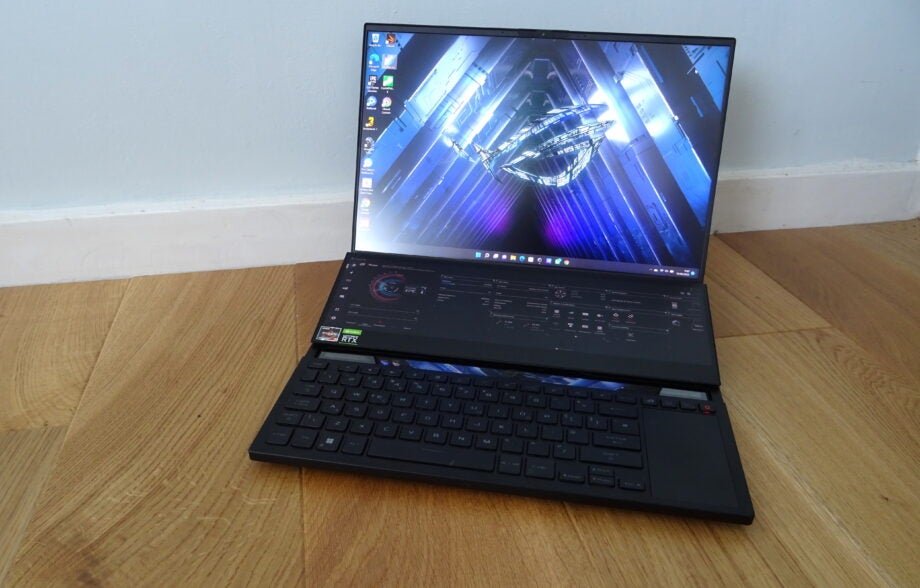

Verdict
The Asus ROG Zephyrus Duo 16 is a hugely powerful gaming laptop with a superb main display and a genuinely useful secondary screen. Yet the design also has some major drawbacks and it’s a very expensive mobile rig. Buy if you really want that second screen, but look elsewhere if it’s not a must have.
Pros
- Brilliant main display
- Useful secondary screen
- Impressive gaming performance
- Ultra-fast storage
Cons
- Large, heavy and expensive
- Lack of game support for second screen
- Poor positioning of keyboard and touchpad
- Noisy in Performance and Turbo modes
Availability
- UKRRP: £4299.95
- USAunavailable
Key Features
- Dual displaysAsus makes a strong case for a smaller second screen, whether you need more space for creative applications or a another display for streaming or running secondary apps.
- High-end performanceWith one of AMD’s fastest CPUs and an RTX 3080Ti, there’s very little that this system won’t run at native resolutions with everything turned up to max.
- StorageYou’ve got 4TB of RAID 0 SSD storage which runs at incredible speeds. Apps and even games boot up quickly and there’s minimal pausing while games load or save.
Introduction
Less has rarely been more when it comes to gaming laptops, but you’ll struggle to find a laptop more committed to maximalism than the Asus ROG Zephyrus Duo 16.
Thanks to its ingenious Screenpad, this Asus has double the displays of your average gaming machine, but the spec of our review model is just as overblown, with a Ryzen 9 6900HX CPU, an RTX 3080Ti GPU, 64GB of DDR5 RAM and 4TB of storage in a RAID 0 SSD array.
From its WiFI 6E connectivity to its 90Whr battery, there’s barely anything about the Duo 16 that you can’t describe as bleeding edge. Needless to say, there’s a steep price to pay for all that good stuff, with prices starting at £2700 and rising to £4300 for our test model.
That’s a lot of money, even for a high-performance gaming laptop. It’s twice as expensive as the Lenovo Legion 7 with its QHD screen, RTX 3080 and Ryzen 7 5800H. It’s even more expensive than the Alienware x17 r2, with a 360Hz 17in screen, 3080Ti and Core i7-12700H. Can two screens justify that cost?
Design and keyboard
- Dual-screen makes the keyboard and touchpad awkward to use
- A solid keyboard with plenty of travel, but no clicky feel
- Ample connectivity with Wi-Fi 6E and Bluetooth 5.2
As with Asus’s other Duo models, the design of the Zephyrus Duo 16 is dominated by its dual screens. The main one is a 16-inch QHD Mini-LED effort with a 2560 x 1600 resolution to cover the squarer 3:2 aspect ratio. The lower one (the Screenpad+) is a touch-sensitive IPS panel with a 3840 x 1100 resolution, and it rises elegantly upwards from the keyboard on a pair of substantial hinged supports.
The design works in giving you a pair of screens you can flick between at comfortable viewing angles, but it has an impact on where everything else has to fit in. They keyboard occupies the front half of the unit, where you’d normally find the wrist rests and the trackpad. The trackpad crams in vertically on the right-hand side. To accommodate the vents around and underneath the Screenpad, all the side-facing connections are pushed to the front as well.
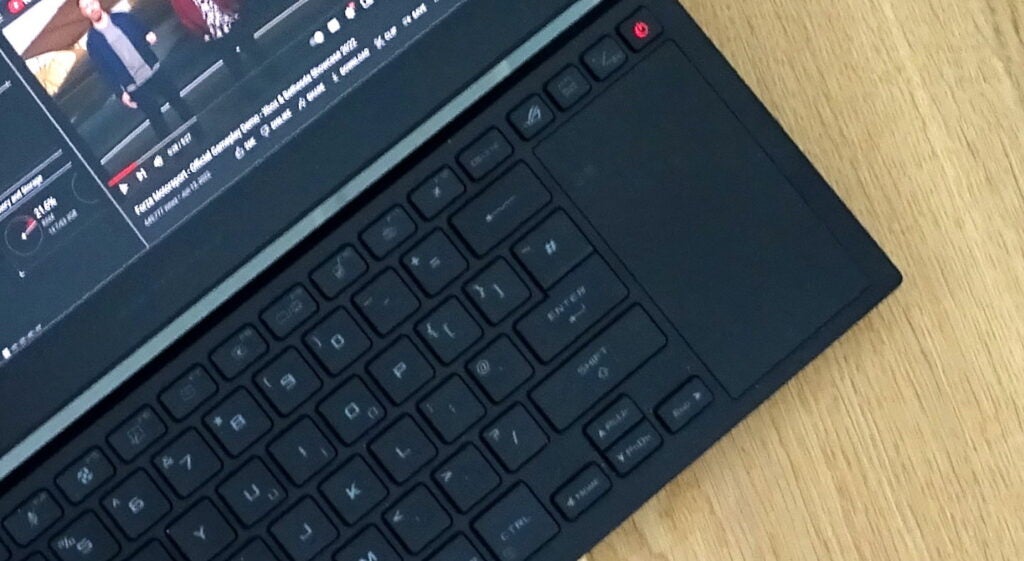
The connections themselves won’t be a problem. You’ve got one USB 3.2 Gen 2 Type-C on the left-hand side, along with a USB 3.2 Gen 2 Type-A, a micro SD card slot and a 3.5mm audio socket. There’s a further USB 3.2 Gen 2 Type-C on the right with charging, plus a further Type A, an HDMI 2.1 and a Gigabit Ethernet port at the rear. However, Asus has put the power socket on the left-hand side right next to the ports and sockets, and with the chunky, reinforced plug and thick cable, this can get in the way.
The Asus ROG Zephyrus Duo 16 has dual-band Wi-Fi 6E support and Bluetooth 5.2 baked in, so you’re equipped to work with the latest high-performance routers, Bluetooth headsets, Bluetooth mice and more.
The external design is as strong as we’ve come to expect from the ROG sub-brand, with a stylish two-layer finish on the lid and a fairly understated logo, while the build quality is rock solid everywhere you look, twist or prod. Yet this design isn’t always practical. The trackpad feels awkward and the tall layout isn’t a natural fit for the basic job of moving the pointer around either screen. Unless disabled, it’s easy to tap with the right pinky finger while you’re trying to press on the Enter, backspace or cursor keys.
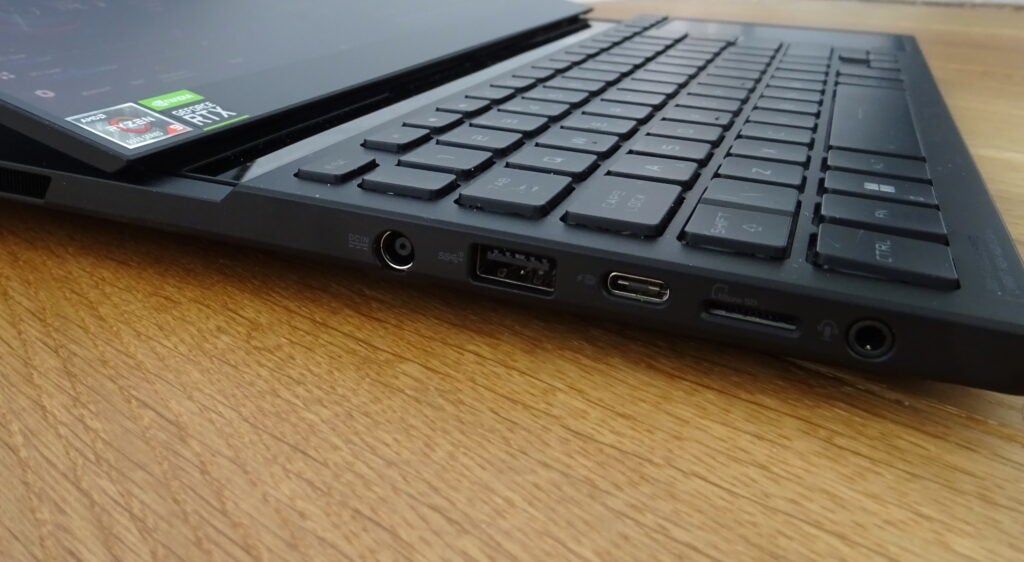
The keyboard itself has a longer than normal 1.7mm of travel, which works well for typing, but doesn’t have the lighter, faster, clicky feel that many gamers are looking for. Plus, while Asus makes up for the lack of palm rests by providing a separate cushioned rest, this isn’t something you’ll want to carry around. In fact, it’s no use at all if you’re working on your lap.
Generally speaking, most PC gamers get their audio from a headset, but if you fancy a spot of gaming without you’ll find the Zephyrus Duo 16’s built-in sound is more than competent. The stereo spread is wide enough and clear enough to track where any shots or footsteps are coming from, and there’s enough bass to give music and effects some impact. What works for games also works for streaming TV shows and movies, though you might want a sound with a bit more subtlety to make the most of music.
Screen
- 2560 x 1600 resolution and 165Hz refresh rate are great for gaming
- Superb brightness and contrast levels, plus excellent coverage of DCI P3
- Secondary Screenpad+ screen is genuinely useful
It’s the screens that really make the Asus ROG Zephyrus Duo 16 special, and each is impressive in its own way. The main display uses Mini LED backlighting, which give you deeper blacks and better contrast than a conventional LED screen. Here you don’t quite reach the dark blacks of an OLED screen, but it’s still noticeably better than most LCD panels, giving you fantastic-looking games and 4K video content, with rich colours and (where supported) impressive HDR effects. The screen supports Dolby Vision HDR and is VESA HDR 1000 certified.
Frankly, it’s a bit of a stunner, as the measurements from our colorimeter back up. It covers 100% of the sRGB gamut and 98% of DCI P3. With a maximum non-HDR brightness level of 791 nits and perfect black levels, contrast is impressively high.
Colour accuracy isn’t quite as perfect, with an average Delta E of 3.08, but it’s close enough that I suspect that only the most hyper-sensitive would spot any issues, and even then there’s nothing you couldn’t fix with proper calibration. Did I mention it’s capable of running at the native 2560 x 1600 resolution at up to 165Hz?
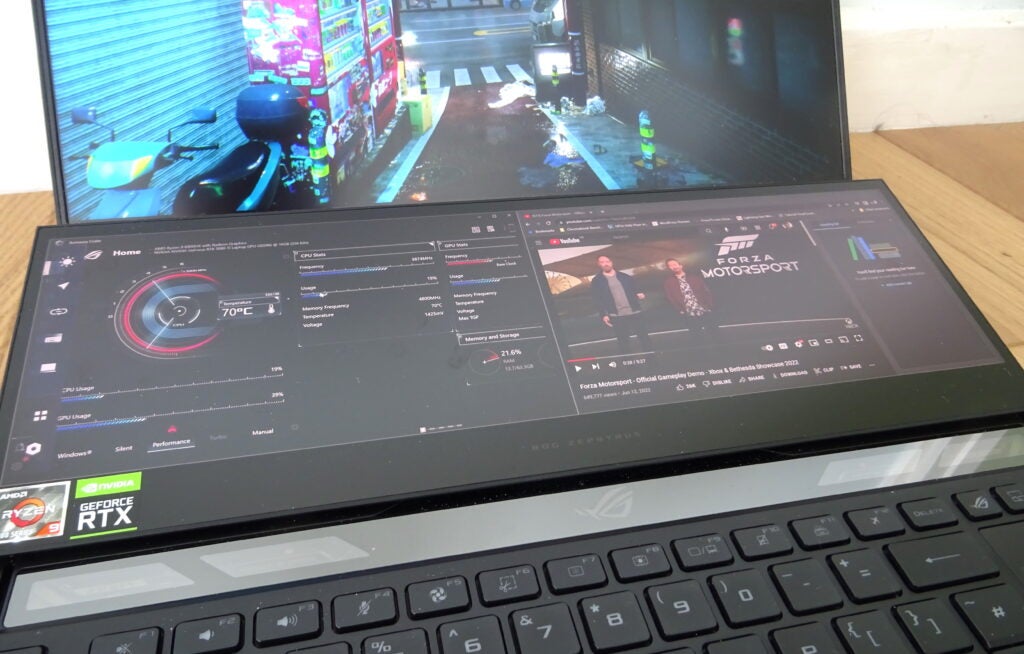
The Screenpad+ isn’t quite as visually impressive, being a dimmer IPS display, but it is genuinely useful. Asus has really worked on the software since unveiling the original Duo machines, and you can now drag, drop and resize windows as you could on any secondary display, or even have windows that span the two displays.
There are plenty of worthwhile applications; you can use the Screenpad+ to hold tool palettes in creative applications, or run apps like Slack, Discord or YouTube while you run your core apps on the main display. You can keep track of your chat and/or your video output while you’re streaming. During various non-E3 events this year I kept the live stream running in the Screenpad+ while I carried on playing games. Right now I’m using it to check specifications and benchmark results while I write this review.
Given that this is a ROG laptop, Asus clearly hopes that you’ll also get to use the Screenpad+ within games. Right now, though, support is very limited. You can manage your inventory and your missions in Dying Light 2 through the touchscreen, without losing your immersion in the game, but until more titles add the same kind of features, your in-game use of the Screenpad+ will probably be limited.
Performance
- Enough performance for 60fps at native resolutions
- More than enough CPU power and RAM for content creation
- 4TB of ludicrously high-speed storage
With its Ryzen 9 6900HX and 64GB of RAM, the Asus ROG Zephyrus Duo 16 is ridiculously, thunderously fast, both in benchmarks and in real-world use. It’s beaten by Intel Core i9-based laptops like the Asus ROG Strix Scar 15 and Alienware X17 R2 in the single-core Geekbench 5 benchmark, but it beats both in the multithreaded test. You’d have to look to the Asus ZenBook Pro Duo, with its Core i7-12700H or the M1 Max MacBook Pro to find better scores.
Its PC Mark 10 score of 6815 is slightly slower than the Asus with its 12th gen Intel processor, but faster than the Alienware with its 11th gen Core i9. Here it beats both the Zenbook Pro 14 Duo and the M1 Max MacBook Pro. You’re not going to have any problems working in mainstream content creation applications, or even most professional tools. This is an extremely capable machine.
Trusted Reviews test data
Add the RTX 3080 Ti to the mix and graphics is every bit as good. The 3DMark TimeSpy score of 11325 is only beaten by the Alienware X17 R2. With minimal tuning, using Asus’s Armory Crate utility to switch from Performance to Turbo mode, I could push the score up to 12273, but this makes the Zephyrus Duo 16 significantly noisier, so there is a price to pay.
As for actual game performance, it’s safe to say that the Zephyrus Duo 16 will comfortably run single-player games at the native resolution, averaging 69fps in Borderlands 3, 90fps in Horizon: Zero Dawn and 69fps in Forza Horizon 5, all at maximum graphics settings.
If you’re playing games with ray tracing enabled, you might see the frame rate drop below 60fps, but here you can either engage DLSS or FSR and scale up from a lower resolution or switch to Turbo mode. Turning on DLSS was enough to boost Horizon: Zero Dawn frame rates by 11fps, while switching to Turbo mode saw frame rates increase to 78fps in Borderlands 3 and 97fps in Horizon: Zero Dawn at native resolution, or 95fps and 119fps at 1080p.
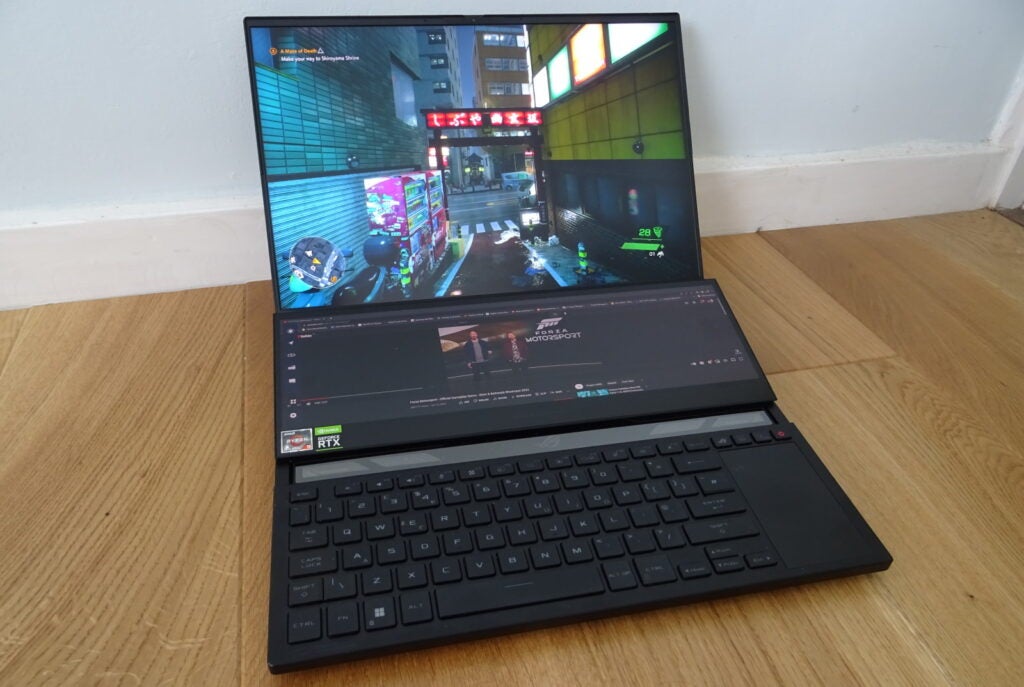
In either Turbo or Performance mode internal temperatures remain under control during gaming, generally staying between 79 and 99℃. The downside is that there is an awful lot of fan noise in Turbo mode, and this isn’t the quietest gaming laptop in Performance mode, either. Luckily, if you’re playing late at night you can still switch to Silent mode and play most games at 60fps, and while ‘silent’ is probably pushing it, it’s not significantly noisier than your average non-gaming laptop in this state.
Finally, we really need to talk about the Zephyrus Duo 16’s storage. Not only do you get 4TB from two 2TB drives in a RAID 0 configuration, but this combo is incredibly fast. CrystalDiskMark recorded sequential read speeds of 11,229MB/sec and write speeds of 9801MB/sec. This doesn’t mean that all apps, games or save games load instantly, but they tend to load faster than you’ll see on other gaming laptops – and with some games they get impressively close.
Battery
- Roughly six hours of use in mainstream apps
- Only an hour of gaming
With that spec and two screens to run it’s not surprising that battery life isn’t brilliant. PC Mark 10’s Modern Office battery benchmark saw the Asus ROG Zephyrus Duo 16 running out of juice in just six hours and two minutes, which mirrored our hands-on experience watching streaming video, browsing the Web and using basic browser-based apps.
More demanding applications are going to hit that battery harder, and playing games you’ll be lucky to reach an hour of use unless you turn the brightness right down. Playing Borderlands 3 at 80% brightness levels, the ROG Zephyrus Duo 16 was ready for bedtime after just 47 minutes of unplugged play.
Like with any gaming laptop with these kind of specs, it’s best used when plugged into the mains and makes a poor on-the-go work machine.
Latest deals
Should you buy it?
You want a powerful gaming laptop and the convenience of the second screen:
Asus has had made numerous compromises to fit in that second screen, while the price has also been driven up. As a result, you really need to make the most out of the second screen to get good value here.
You want a lighter gaming laptop:
Thanks to the screen and powerful specs, this is one of the heavier gaming laptops on the market. You an find significantly lighter options, such as the Asus ROG Zephyrus G14, if you fancy a more portable gaming laptop.
Final Thoughts
The Asus ROG Zephyrus Duo 16 is a best-of-breed gaming laptop with not one, but two fantastic screens, but you have to really want that second screen to make the expense worthwhile. What’s more, it actively makes the laptop less comfortable to use in a range of everyday tasks. If you’re not going to make the most of this laptop’s key feature, you’re arguably better served by a more conventional design.
How we test
Every gaming laptop we review goes through a series of uniform checks designed to gauge key things including build quality, performance, screen quality and battery life.
These include formal synthetic benchmarks and scripted tests, plus a series of real world checks, such as how well it runs when running a AAA game.
We used as our main laptop for at least a week.
Tested the performance via both benchmark tests and real-world use.
We tested the screen with a colorimeter and real-world use.
We tested the battery with a benchmark test and real-world use.
FAQs
Yes, the Asus ROG Zephyrus is designed for gaming, and can be configured with some of the most powerful CPUs, GPUs and SSDs for laptops.
No, this laptop does not have a fingerprint sensor.
Trusted Reviews test data
Full Specification
Sustainability
TrustedReviews’ holds the fact that global warming is not a myth as a core value and will continuously endeavor to help protect our planet from harm in its business practices.
As part of this mission, whenever we review a product we send the company a series of questions to help us gauge and make transparent the impact the device has on the environment.
We currently haven’t received answers to the questions on this product, but will update this page the moment we do. You can see a detailed breakdown of the questions we ask and why in our sustainability info page.







